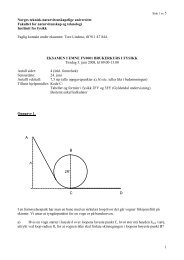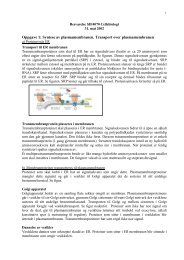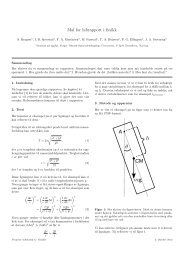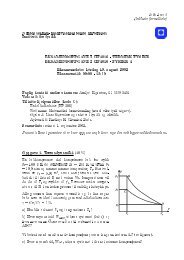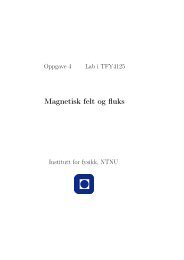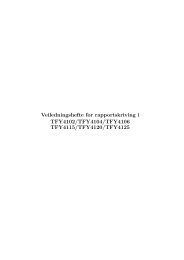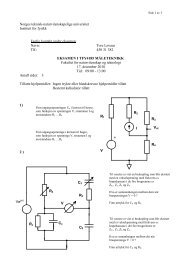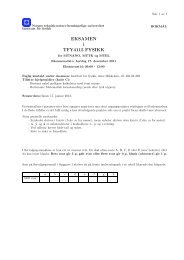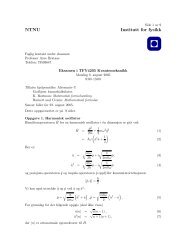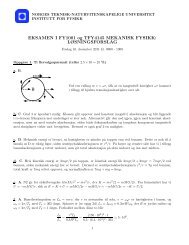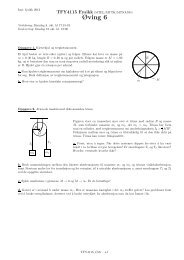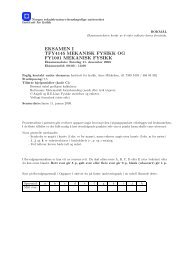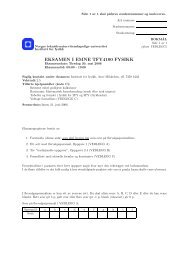DEPARTMENT OF PHYSICS, NTNU - intern - NTNU
DEPARTMENT OF PHYSICS, NTNU - intern - NTNU
DEPARTMENT OF PHYSICS, NTNU - intern - NTNU
You also want an ePaper? Increase the reach of your titles
YUMPU automatically turns print PDFs into web optimized ePapers that Google loves.
DIVISION <strong>OF</strong> CONDENSED MATTER <strong>PHYSICS</strong><br />
Staff<br />
Professor Anne Borg<br />
Professor Johannes Bremer<br />
Ass. professor Jon Otto Fossum<br />
Professor Kristina Fossheim<br />
Professor Randi Holmestad<br />
Professor Ola Hunderi<br />
Professor Ragnvald Høier<br />
Profssor Frode Mo<br />
Professor Steinar Raaen<br />
Professor Emil J. Samuelsen<br />
Ass. Professor Bård Tøtdal<br />
Professor emeritus Ivar Svare<br />
Guests<br />
Dr. Ali Ata (Post doc.)<br />
Dr. Geraldo da Silva (Post doc.)<br />
Dr. Yinda Yu (Post doc. 20%)<br />
Dr. Jian Wang (Post doc.)<br />
Overview<br />
The research activities include a variety of topics in<br />
experimental Condensed Matter Physics. The members<br />
of the division work with many different experimental<br />
techniques for studying physical properties of materials<br />
and material structures. A brief survey of the research<br />
is given. For the year 2002 two research projects are<br />
described in more details.<br />
Survey of research activities<br />
Superconductivity in low-Tc and high Tc<br />
superconductors<br />
By K. Fossheim<br />
The roles of the BCS coherence factors vs. Meissner<br />
screening were studied in 6N grade single crystalline<br />
superconducting aluminium by transversely polarized<br />
ultrasound in the 100-300 MHz range with submillikelvin<br />
temperature resolution below Tc =1.17 K.<br />
The coherence factors were found to dominate the<br />
electron-phonon interaction within a 2 millikelvin<br />
range below Tc, followed by Meissner screening. The<br />
theory developed in the group fully agrees, and<br />
explains the data.<br />
Measurements of the elastic properties of the flux line<br />
lattice in superconducting La1.85Sr0.15CuO4 were made<br />
with unprecedented resolution and in fields of 0 - 5 T,<br />
using an in-house developed acoustic resonance<br />
method. Measurements revealed critical behaviour near<br />
Tc, and a distinct contribution to elastic constants over<br />
the entire superconducting range.<br />
Systematic processing efforts were made to generate<br />
flux-pinning centers in superconducting<br />
Bi2Sr2Ca1Cu2O8 by creation of nanoscale MgO<br />
precipitates. Careful TEM studies confirmed that such<br />
precipitates were formed in the superconducting<br />
15<br />
matrix, and magnetization measurements showed that<br />
improved pinning was achieved.<br />
Crystallography methods and<br />
instrumentation<br />
By F. Mo<br />
A major activity has been development and testing of a<br />
gas-flow thermostat sample cell with control of relative<br />
humidity and equipment for the application of an<br />
electric DC field on the crystal. The cell is designed<br />
for diffraction experiments with crystals that are<br />
unstable and denature easily upon changes in<br />
temperature and/or relative humidity under Xradiation.<br />
Crystals of the ferroelectric compound,<br />
Rochelle salt, have been used in this work. All<br />
experiments were carried out on the Swiss-Norwegian<br />
Beamlines at ESRF.<br />
Transition electron microscopy<br />
By R. Holmestad, R. Høier, B. Tøtdal<br />
During 2002 the research activities have included<br />
micro/nanostructure studies of functional perovskite<br />
materials, ferroelastic materials, thin films, alloy<br />
nanoparticles in catalysts and materials for hydrogen<br />
storage/metal hydrides; bonding in materials/structure<br />
factor refinements, studied by convergent beam<br />
electron diffraction (CBED); alloy development and<br />
nucleation of precipitates in aluminium alloys;<br />
structure determination of metastable, hardening<br />
phases; atomistic modelling and ab initio methods in<br />
materials science; surface studies of light metals;<br />
nanoscale oxide layers, corrosion behaviour.<br />
The group received their new 200keV field emission<br />
gun transmission electron microscope (FEG-TEM) this<br />
year.<br />
Optical and magnetooptical properties of<br />
substituted iron garnet films<br />
By J. Bremer and O. Hunderi<br />
A series of approximately 4 mm thick Bi:ferrimagnetic<br />
garnets (FG) films grown by LPE on (100) oriented<br />
Gallium Gadolinium Garnet (GGG) substrates have<br />
been studied. The films have in-plane magnetization<br />
and were grown for magnetic-field imaging purposes.<br />
From variable angle spectroscopic ellipsometry<br />
(VASE) and magnetooptical Kerr effect (MOKE)<br />
measurements on magnetically saturated films, we<br />
have determined the diagonal and off-diagonal<br />
permittivity tensor elements of the garnet films in the<br />
range 1.5-5eV. The spectral behaviour of the offdiagonal<br />
tensor elements have been interpreted in terms<br />
of electric dipole transitions and related to the<br />
composition of the samples.<br />
Scanning probe microscopy studies of<br />
surfaces<br />
By A. Borg<br />
During this year a research effort has been initiated on<br />
using the tip in a scanning tunneling microscope



